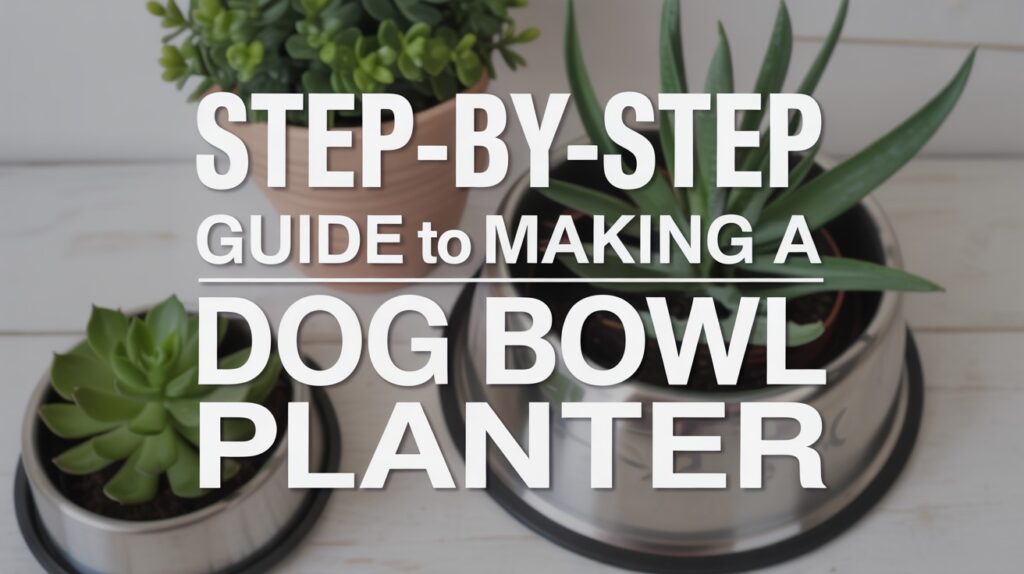A dog bowl planter represents one of the smartest dual-purpose projects you can tackle for your home.
This clever solution addresses two common household challenges simultaneously: keeping floors dry around pet feeding areas and providing your indoor or outdoor plants with consistent hydration.
The concept works by repurposing standard dog bowls into functional planters that catch excess water while maintaining proper drainage for healthy plant growth.
This simple DIY idea proves perfect for pet owners and plant lovers alike, offering practical benefits that extend beyond basic aesthetics.
Whether you’re dealing with messy water spills from enthusiastic drinkers or struggling to maintain proper watering schedules for your greenery, this project creates an efficient system that serves both needs.
The result is a tidy, organized space that benefits both your pets and plants.
What Is a Dog Bowl Planter?
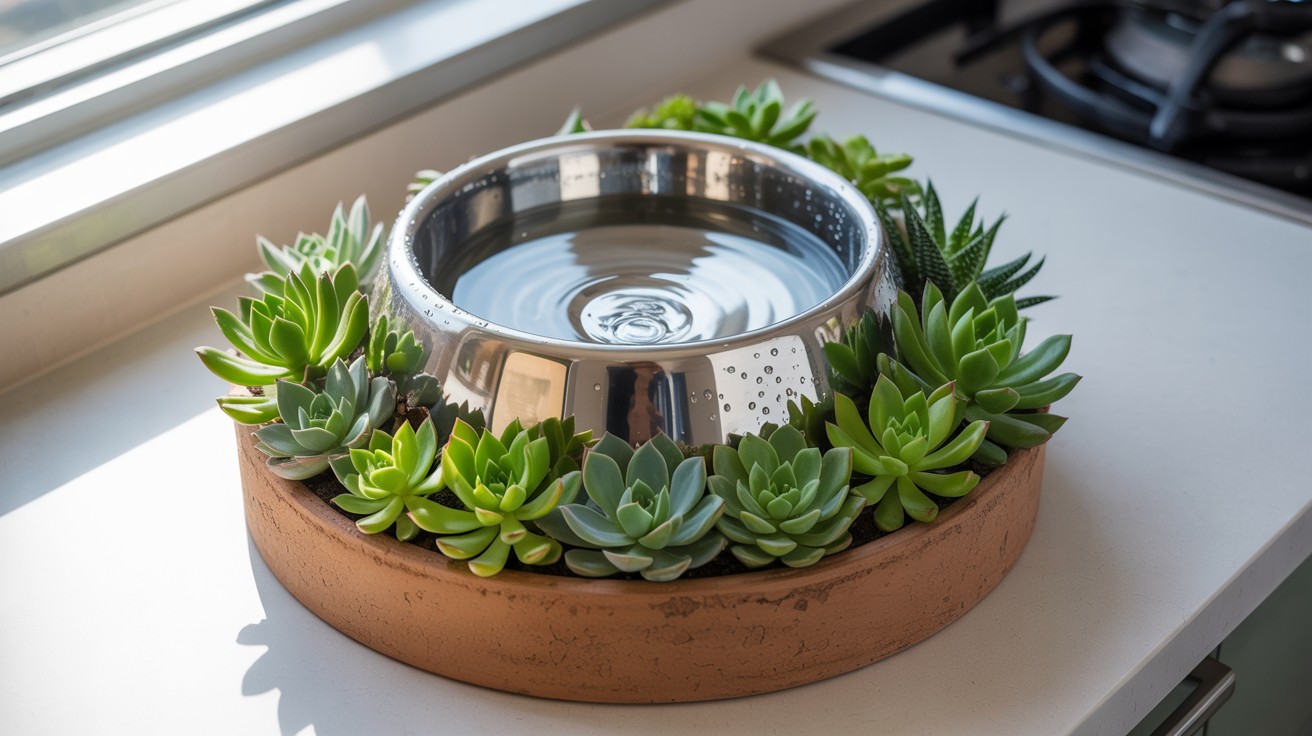
A dog bowl planter combines practicality with aesthetics by creating a decorative setup that incorporates your pet’s water bowl within a surrounding planter system.
This innovative design transforms a basic pet feeding station into an attractive garden feature that serves multiple purposes throughout your home or yard.
The system works by strategically positioning plants around your dog’s water bowl so that any splashes or overflow naturally help nourish the surrounding greenery.
When your pet drinks enthusiastically or accidentally tips their bowl, the spilled water doesn’t create a mess on your floors-instead, it provides much-needed hydration for nearby plants.
This versatile setup works particularly well in kitchens where you can monitor both your pet’s water intake and plant health easily.
Patios offer another excellent location, creating an outdoor feeding station that doubles as a decorative garden element.
Shaded outdoor spots also benefit from this arrangement, as the consistent moisture helps plants thrive in areas that might otherwise receive irregular watering.
The combination creates a win-win situation where your pet stays hydrated while your plants receive supplemental water from natural pet activity.
Supplies You’ll Need
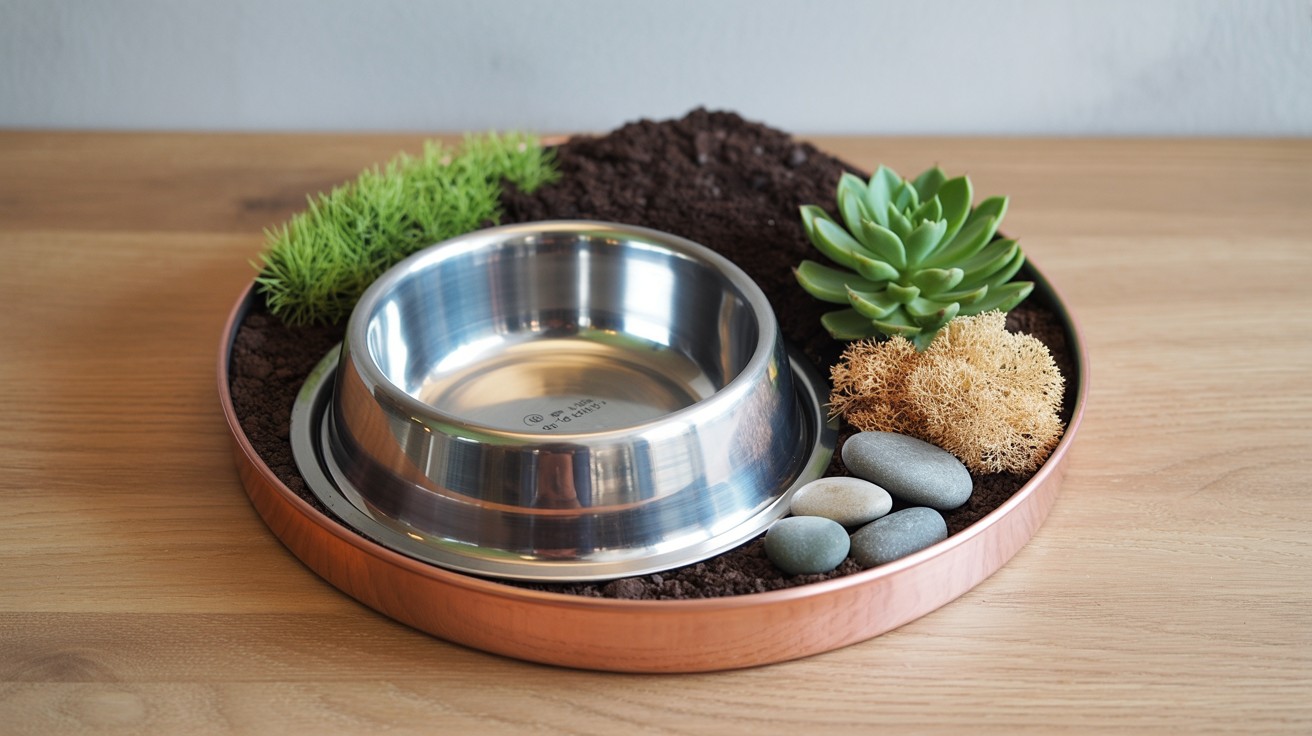
Complete list of basic materials and optional items needed to create your functional dog bowl planter project.
Basic Materials
- 1 ceramic or stainless steel dog bowl – Choose a size appropriate for your pet’s drinking needs
- 1 plastic bowl (same size as the water bowl) – Acts as a liner to protect the main setup
- 1 metal tray or round pan – Should be about 2″ deep and 13″ wide or larger to accommodate the bowl and plants
- Succulent or houseplant potting mix – Provides proper drainage and nutrients for healthy plant growth
- Pet-safe plants – Options include succulents, ferns, moss, or other non-toxic varieties safe around animals
- Decorative stones or pebbles – Adds visual appeal while helping with drainage and preventing soil spillage
Optional Items
- Grow light for indoor settings – Helpful when placing the planter in areas with limited natural sunlight
- Tray liner or saucer – Provides extra protection for outdoor surfaces and easier cleanup maintenance
How to Make a Dog Bowl Planter: Step-by-Step Instructions
Complete step-by-step instructions for assembling your dog bowl planter from setup to final water filling and placement.
Step 1: Place the Plastic Bowl in the Tray
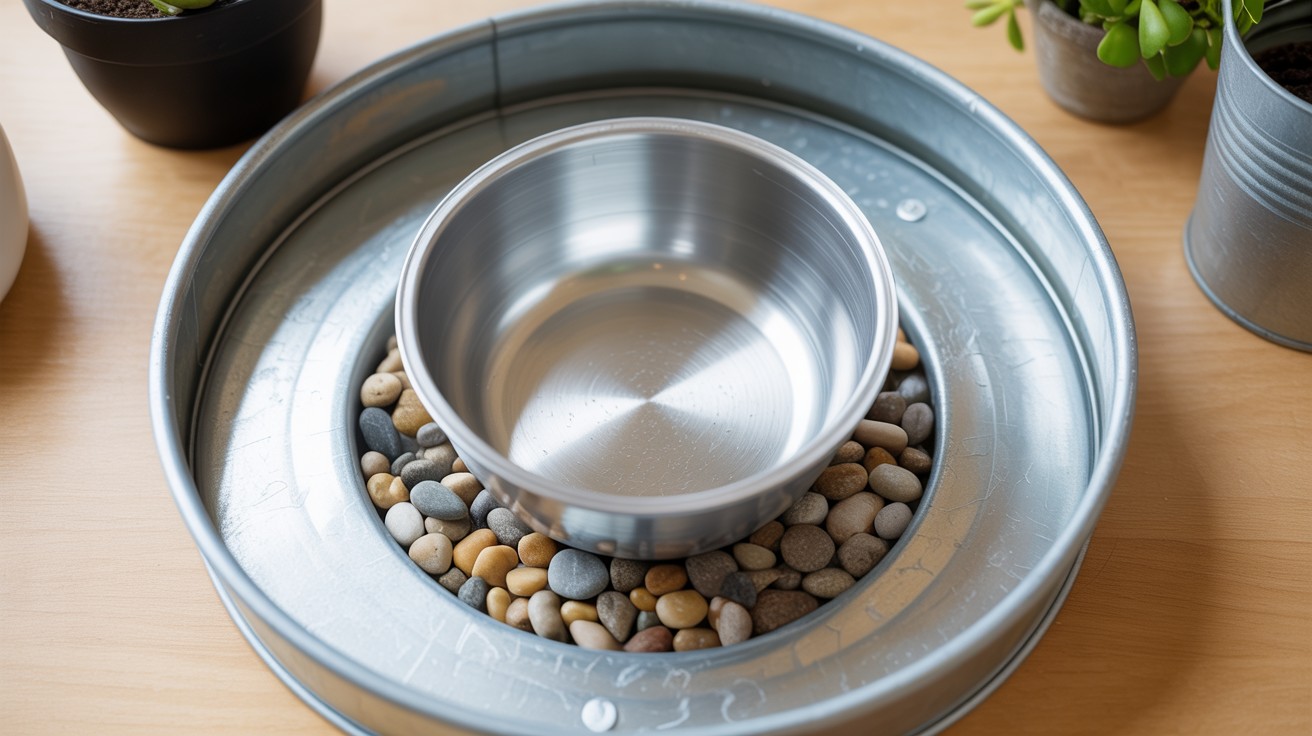
Begin by selecting the center point of your metal tray and carefully positioning the plastic bowl to ensure even spacing on all sides.
The bowl should sit flat against the bottom without wobbling or tilting.
Once centered, add a generous layer of small stones or pebbles around the base of the plastic bowl, pressing them firmly into place.
These stones serve multiple purposes: they anchor the bowl securely, prevent it from shifting during use, and create proper drainage channels for excess water.
Make sure the stones don’t spill into the bowl interior, as this space needs to remain clean for your pet’s water bowl.
Step 2: Add Potting Mix Around the Bowl
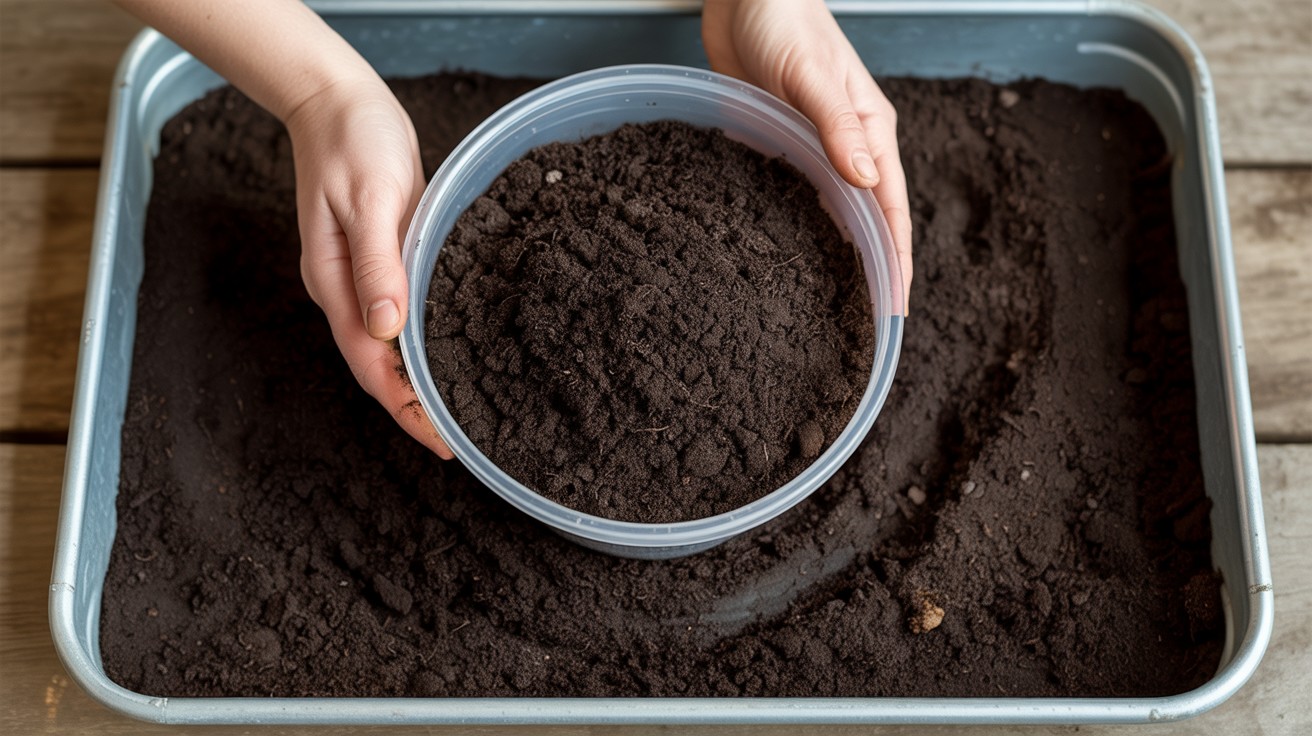
Choose a high-quality potting mix specifically designed for the types of plants you plan to use-succulent mix for drought-tolerant plants or general houseplant soil for ferns and other moisture-loving varieties.
Begin filling the space around the plastic bowl gradually, working the soil gently with your hands to eliminate air pockets.
Fill to within about half an inch of the tray’s rim, leaving adequate space for plant placement and future watering.
Avoid compacting the soil too firmly, as roots need oxygen and space to spread.
The soil level should be slightly below the rim of the plastic bowl to prevent contamination of your pet’s drinking water.
Step 3: Arrange and Plant Pet-Safe Greenery
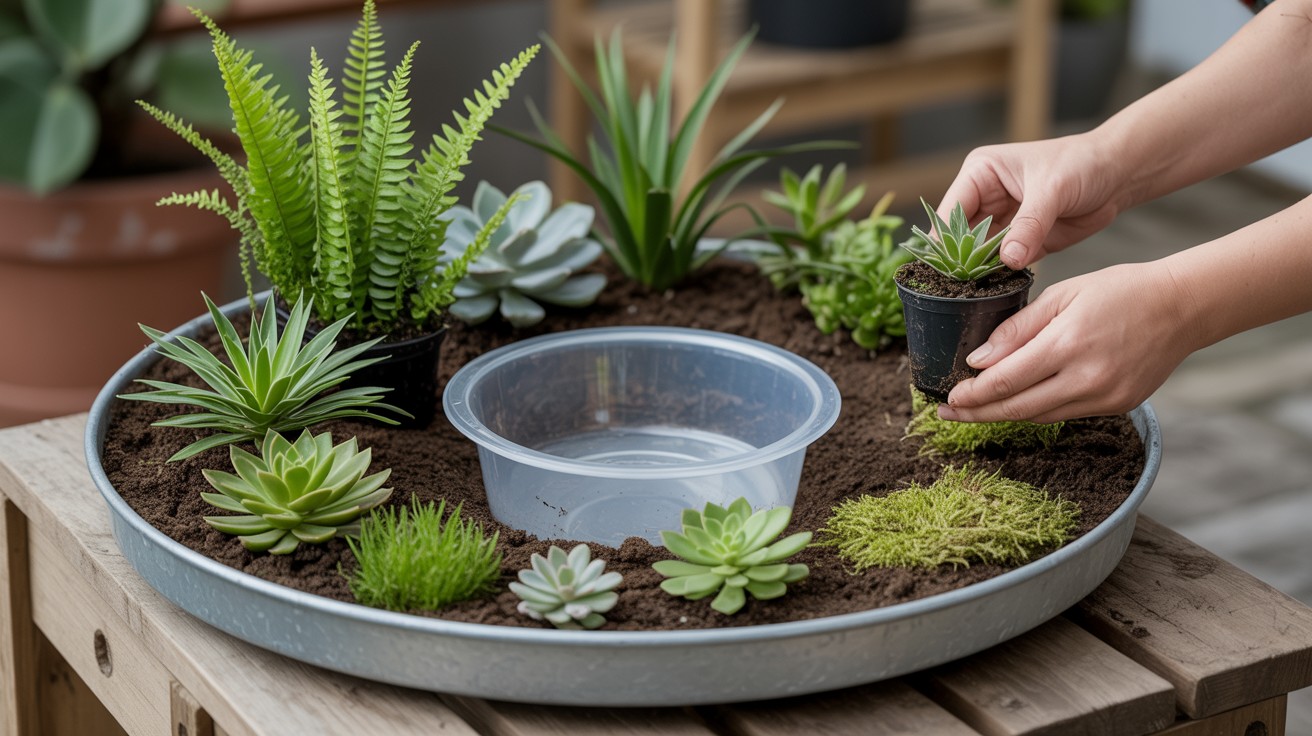
Research pet-safe plant options thoroughly before making selections, as some common houseplants can be toxic to dogs and cats.
Excellent choices include spider plants, Boston ferns, most succulents, and various mosses.
Plan your arrangement by considering mature plant sizes and growth patterns-place taller specimens like ferns toward the back or center, medium-height plants in the middle areas, and trailing or compact varieties near the edges.
Create small planting holes with your fingers, gently remove plants from their nursery containers, and loosen any tightly bound roots before placing them in the soil.
Water each plant lightly after positioning to help them settle into their new environment.
Step 4: Add Decorative Pebbles
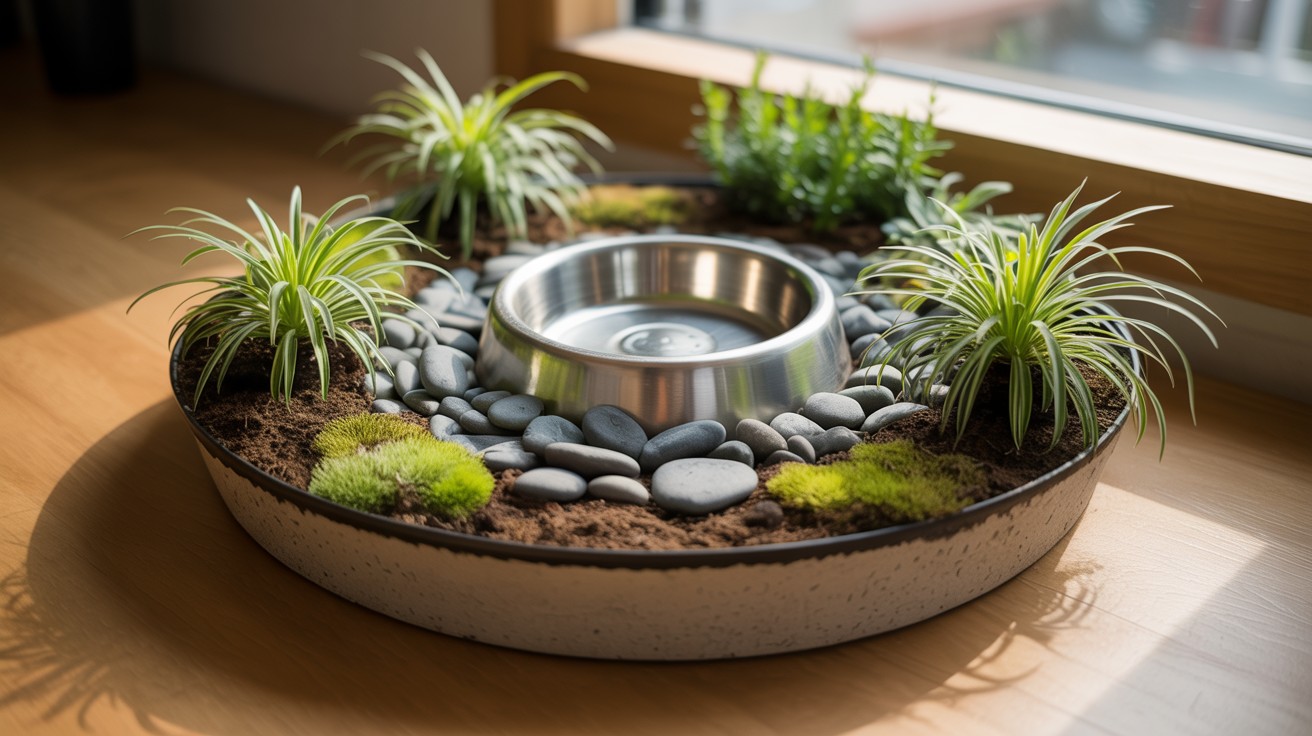
Select pebbles or decorative stones that complement your home’s aesthetic-smooth river rocks for a natural look, colored glass stones for modern appeal, or polished granite chips for sophisticated elegance.
Carefully spread the stones over all exposed soil surfaces, creating an even layer about half an inch thick.
Use your fingers to work pebbles around plant bases without damaging stems or leaves.
This decorative layer serves practical purposes by preventing soil erosion when water splashes occur, reducing fungus gnat problems, and creating a professional, finished appearance that enhances your home’s decor.
Step 5: Nest the Water Bowl and Fill It
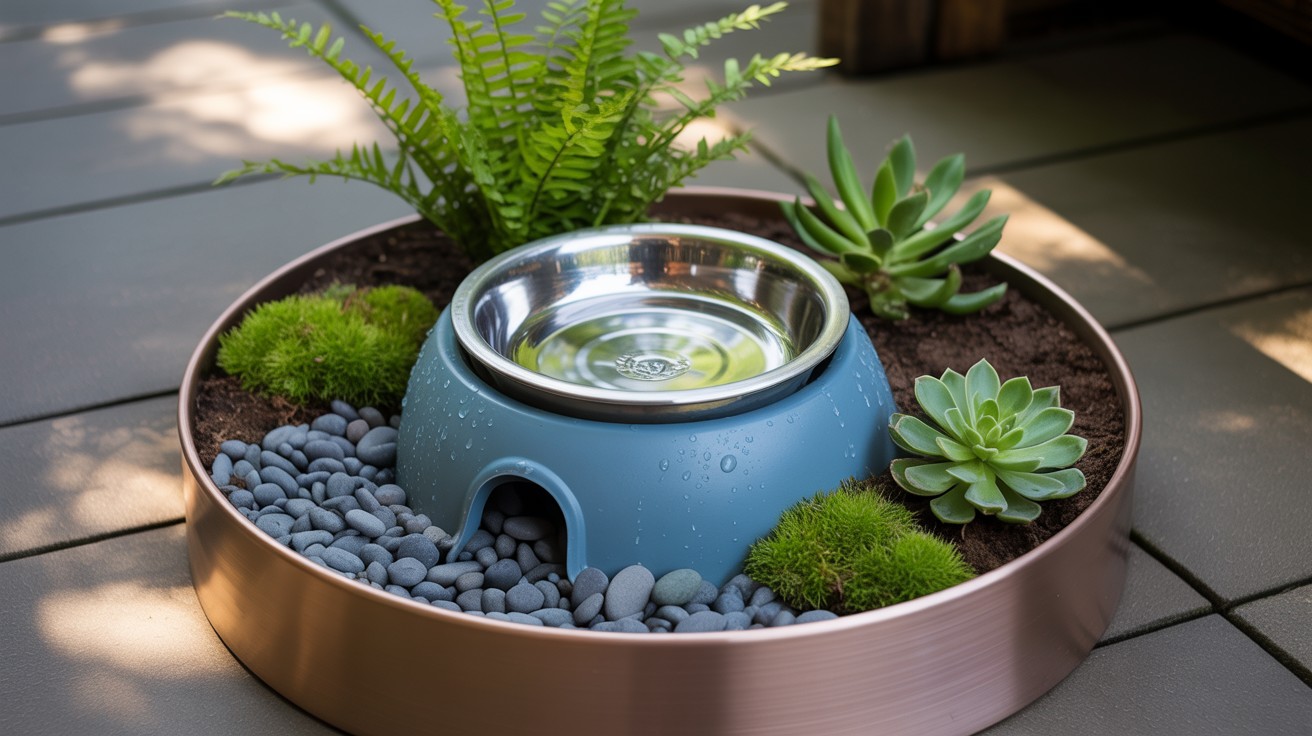
Take your dog’s regular ceramic or stainless steel water bowl and lower it carefully into the plastic bowl holder, checking that it sits level and stable without rocking.
The rim should be slightly above the surrounding soil level to prevent contamination from plant debris.
Fill the bowl with fresh, clean water appropriate for your pet’s daily needs.
Place the completed planter in your chosen location-whether kitchen corner, patio area, or shaded garden spot-and observe how your pet’s natural drinking habits provide consistent moisture for the surrounding plants while keeping your floors cleaner and your greenery healthier.
Tips for Success
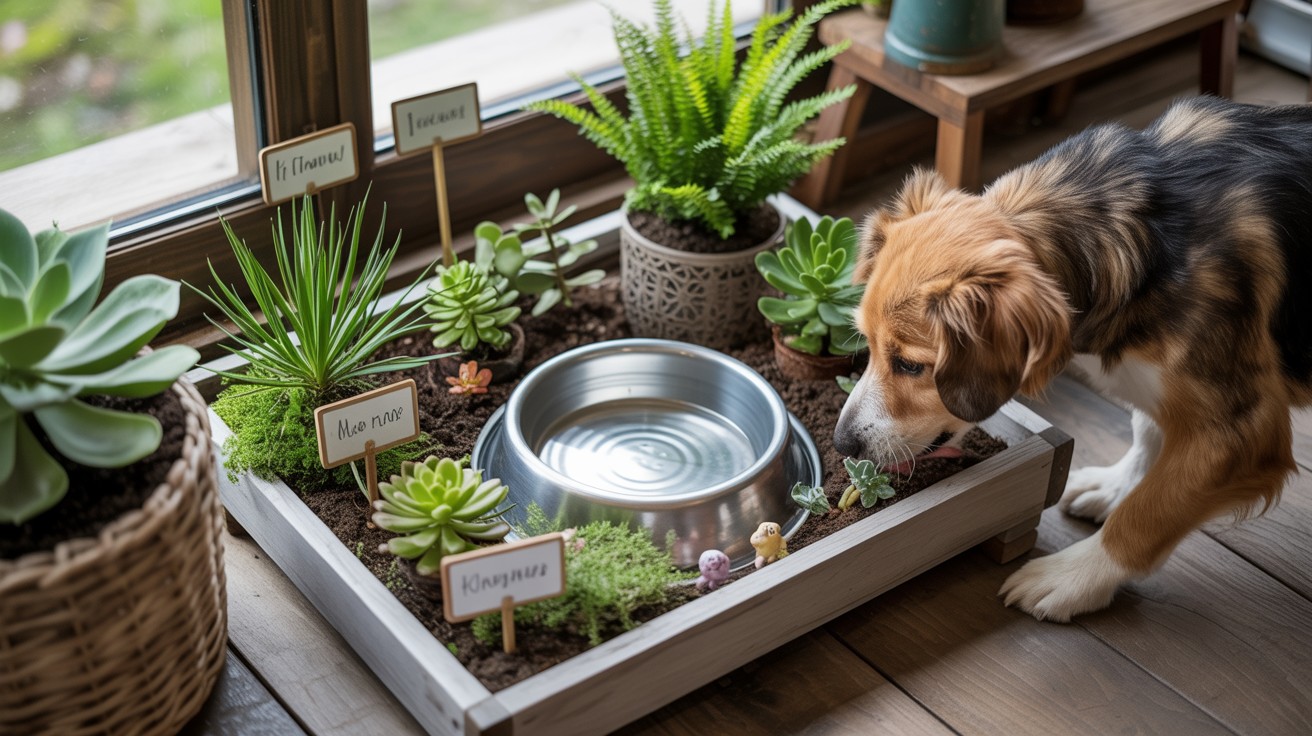
Essential tips for proper placement, watering techniques, and customization ideas to ensure your dog bowl planter thrives successfully.
Location Matters
Place your planter near a window indoors or in a shaded outdoor spot for optimal plant health.
Avoid direct hot sun if using tropical or moisture-loving plants, as intense heat can stress vegetation and overheat your pet’s water.
Consider foot traffic patterns to ensure easy access for your dog while protecting plants from damage.
Watering Tips
Monitor soil moisture levels regularly by checking if the soil feels slightly damp but not waterlogged.
Your dog’s drinking habits should provide adequate moisture for most plants, but supplement during hot weather if needed.
If excess water accumulates and creates soggy conditions, temporarily move the planter outdoors for better drainage.
Customizing Your Planter
Use themed containers that match your home’s decor style-rustic wooden trays for farmhouse looks or sleek metal for modern aesthetics.
Add small garden signs with your pet’s name or plant labels for personality.
Swap out plants seasonally for fresh appearances, using spring bulbs, summer flowers, or evergreen varieties to keep the arrangement interesting year-round.
Final Thoughts
A dog bowl planter represents the perfect marriage of pet care and plant care, creating a functional solution that addresses multiple household needs simultaneously.
This creative project transforms an ordinary pet feeding station into an attractive focal point that works beautifully in both indoor and patio spaces.
The dual-purpose design ensures your pet stays properly hydrated while your plants receive consistent moisture from natural splashing activity.
This beginner-friendly project requires minimal tools, basic materials, and simple assembly techniques that anyone can master regardless of their DIY experience level.
The rewarding outcome provides immediate satisfaction as you watch both your pet and plants thrive in this thoughtfully designed environment.
Whether you’re a seasoned gardener or complete novice, this project offers an accessible entry point into creative home improvement that benefits every member of your household.
Frequently Asked Questions
What plants are safe to use around my dog’s water bowl?
Choose pet-safe options like spider plants, Boston ferns, most succulents, and various mosses that won’t harm your dog if accidentally ingested. Always research specific plant varieties before purchasing and avoid common toxic plants like lilies, azaleas, or snake plants.
How often should I clean and refill the water bowl in this setup?
Clean and refill your dog’s water bowl every 2-3 days or whenever it appears dirty, just like a regular water bowl. The surrounding plants don’t affect water quality, but regular maintenance ensures your pet always has fresh, clean drinking water available.
Can I use this planter outdoors year-round?
Yes, but choose weather-appropriate plants and consider seasonal changes that might affect both your pet’s comfort and plant survival. Move the planter to protected areas during extreme weather or harsh winter conditions to prevent damage.
What size tray works best for different dog breeds?
Use a 13-inch wide tray for small to medium dogs, while larger breeds may need 15-18 inch trays for adequate space. The tray should accommodate your dog’s bowl size plus 3-4 inches on all sides for proper plant placement.
How do I prevent my dog from digging in the soil?
Cover all exposed soil with decorative pebbles or stones to discourage digging behavior and create a clean appearance. Choose plants with sturdy stems and position them away from your dog’s immediate drinking area to minimize disturbance.

